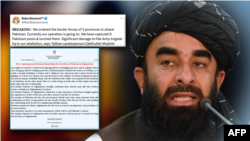On March 18, Pakistan conducted air strikes purportedly targeting armed groups hiding in regions of Afghanistan bordering Pakistan.
Al Jazeera reported, citing Pakistani military and foreign ministry sources, that the attacks targeted commanders of the Tehreek-e-Taliban Pakistan, or TTP, also known as the Pakistani Taliban, for “terrorist activities being sponsored and conducted from across the border.”
Later that day, the Afghan defense ministry said its forces had fired on Pakistani positions across the border.
Such skirmishes are routine in the border areas between Pakistan and Afghanistan, as both countries accuse each other of harboring terrorist groups.
These frequent escalations also agitate social media users, including disinformation actors and others prone to seizing breaking news to gain momentum and increase their visibility by posting sensational and often false updates, as Polygraph.info previously reported.
On X, influencer Baba Banaras — self-described as “defence enthusiastic” and living in Pakistan — used the “breaking” key word to post a fake Taliban announcement of a military invasion of Pakistan.
On March 18, Banaras posted for his more than 44,000 followers this statement, attributed to Taliban spokesperson Zabihullah Mujahid:
“BREAKING: We ordered the border forces of 3 provinces to attack Pakistan. Currently our operation is going on. We have captured 9 Pakistani posts & torched them. Significant damage to Pak Army brigade hq in our retaliation, says Taliban spokesperson Zabihullah Mujahid.”
That is false.
Taliban spokesman Zabihullah Mujahid made no such statement, and Afghanistan did not invade Pakistan.
The post has since gained nearly 40,000 views and more than 1,500 likes and reposts. There is no community note added to it to mark its content as untrustworthy.
In fact, on March 18, Taliban spokesman Zabihullah Mujahid issued a statement in English, Pashto and Dari, saying that Pakistani planes had bombed civilian houses in Afghanistan’s Paktika and Khost provinces, killing three women and three children in the former and two women in the latter.
“The Islamic Emirate of Afghanistan strongly condemns these attacks and calls this reckless action a violation of Afghanistan's territory,” the statement read, adding that such incidents could have “very bad consequences which will be out of Pakistan’s control.”
That same day, residents in Kurram, a western district in Pakistan's northwestern Khyber Pakhtunkhwa Province, told VOA sister organization Radio Free Europe/Radio Liberty (RFE/RL) that the Taliban had shelled the area. There were no immediate reports of casualties or damage, and there were no reports of Taliban forces on the ground in Pakistan.
The reported Taliban strikes followed a March 16 militant attack on a large Pakistani army post in the volatile North Waziristan district near Pakistan’s border with Afghanistan that killed seven Pakistani soldiers and wounded 17 others.
RFE/RL noted that pro-Taliban accounts on X shared a video purportedly showing Taliban rocket attacks on Pakistani installations in the border town of Kharlachi, a major crossing and trade hub between the two countries.
Pakistan said a military confrontation with Afghanistan is “the last resort.”
"We do not seek armed conflict with Afghanistan," Pakistan’s Defense Minister Khawaja Asif told VOA on March 20. Asif said that if Kabul didn’t suppress anti-Pakistan terrorist activities emanating from Afghan territory, Islamabad might block Afghanistan’s trade corridor with India.
The roots of the border dispute between Afghanistan and Pakistan reach far back into the colonial history of the region.
The “Durand Line,” named after Mortimer Durand, the late-19th century secretary of the British government in India, marks the current border between Afghanistan and Pakistan.
Established by an 1893 agreement between the British authorities and the Amir of Afghanistan Abdur Rahman Khan, the Durand Line created long-lasting grievances.
At the time of the treaty, there was no Pakistan, and the area was under the control of the British Raj, the British Crown’s rule on the Indian subcontinent. The Durand Line meant that after Pakistan gained independence in 1947, the region’s Pashtun population found themselves divided between Pakistan and Afghanistan.
Pakistan recently erected a 2,670-kilometers-long border fence (1,660 miles), which has made matters worse for many Pashtun tribes, destroying small businesses and depriving many people of the means to earn a living and support their families.
The administration in Pakistan’s Punjab province also pushes a “resentment” policy, forcing Pashtuns to relocate deeper into Pakistani territory and further severing ties with their Afghan kin.
Tensions remain high as the Pakistani army, predominantly comprised of Punjabis, controls one side of the border, and the Taliban, primarily composed of Pashtuns, operates on the other.
The Taliban recently reaffirmed its opposition to the 1893 border agreement, claiming it divides Afghanistan in “half.”
"We have never acknowledged the Durand Line and will never do so. Currently, half of Afghanistan lies beyond this boundary,” Sher Mohammad Abbas Stanikzai, deputy foreign minister of the Islamic Emirate of Afghanistan, said in February.
In an address on the 35th anniversary of the withdrawal of Soviet troops from Afghanistan, Stanikzai described the Durand Line as a “symbolic division imposed by the English, etched into the hearts of Afghans.”





